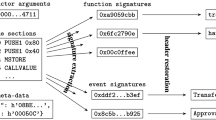Abstract
A prominent use case of Ethereum smart contracts is the creation of a wide range of user-defined tokens or assets by way of smart contracts. User-defined assets are non-native on Ethereum; i.e., they are not directly supported by the ledger, but require repetitive custom code. This makes them unnecessarily inefficient, expensive, and complex. It also makes them insecure as numerous incidents on Ethereum have demonstrated. Even without stateful smart contracts, the lack of perfect fungibility of Bitcoin assets allows for implementing user-defined tokens as layer-two solutions, which also adds an additional layer of complexity.
In this paper, we explore an alternative design based on Bitcoin-style UTXO ledgers. Instead of introducing general scripting capabilities together with the associated security risks, we propose an extension of the UTXO model, where we replace the accounting structure of a single cryptocurrency with a new structure that manages an unbounded number of user-defined, native tokens, which we call token bundles. Token creation is controlled by forging policy scripts that, just like Bitcoin validator scripts, use a small domain-specific language with bounded computational expressiveness, thus favouring Bitcoin’s security and computational austerity. The resulting approach is lightweight, i.e., custom asset creation and transfer is cheap, and it avoids use of any global state in the form of an asset registry or similar.
The proposed UTXO\(_{\textsf {ma}}\) model and the semantics of the scripting language have been formalised in the Agda proof assistant.
Access this chapter
Tax calculation will be finalised at checkout
Purchases are for personal use only
Similar content being viewed by others
Notes
- 1.
- 2.
We have chosen to represent \(\textsf {Quantities}\) as a finitely-supported function whose values are themselves finitely-supported functions (in an implementation, this would be a nested map). We did this to make the definition of the rules simpler (in particular Rule 8). However, it could equally well be defined as a finitely-supported function from tuples of \(\textsf {PolicyID}\)s and \(\textsf {Asset}\)s to \(\textsf {Quantity}\)s.
- 3.
The restriction on outputs is enforced by Rule 2. We simply do not impose such a restriction on the \( forge \) field: this lets us define rules in a simpler way, with cleaner notation.
- 4.
KYC stands for “know your customer”, which is the process of verifying a customer’s identity before allowing the customer to use a company’s service.
References
Lightning Network multi-asset channels (2016). https://github.com/lightningnetwork/lightning-rfc/pull/72
Atzei, N., Bartoletti, M., Lande, S., Zunino, R.: A formal model of bitcoin transactions. In: Meiklejohn, S., Sako, K. (eds.) FC 2018. LNCS, vol. 10957, pp. 541–560. Springer, Heidelberg (2018). https://doi.org/10.1007/978-3-662-58387-6_29
Buterin, V., Hakim, L., Rosenfeld, M., Lev, R.: Liquid: a bitcoin sidechain (2012)
Chakravarty, M.M.T., et al.: Native custom tokens in the extended UTXO model. In: Margaria,T., Steffen, B. (eds.) ISoLA 2020. LNCS, vol. 12478, pp. 89–111. Springer, Heidelberg (2020). https://omelkonian.github.io/data/publications/eutxoma.pdf
Chakravarty, M.M.T., Chapman, J., MacKenzie, K., Melkonian, O., Peyton Jones, M., Wadler, P.: The extended UTXO model. In: Bernhard, M., et al. (eds.) FC 2020. LNCS, vol. 12063, pp. 525–539. Springer, Cham (2020). https://doi.org/10.1007/978-3-030-54455-3_37
Chakravarty, M.M.T., et al.: Hydra: fast isomorphic state channels. Technical report, Cryptology ePrint Archive, Report 2020/299 (2020). https://eprint.iacr.org/2020/299
DAML Team: DAML SDK documentation (2020). https://docs.daml.com/
Entriken, W., Shirley, D., Evans, J., Sachs, N.: ERC-721 non-fungible token standard. Ethereum Foundation (2018). https://eips.ethereum.org/EIPS/eip-721
Goodman, L.: Tezos–a self-amending crypto-ledger white paper (2014)
Nakamoto, S.: Bitcoin: a peer-to-peer electronic cash system (2008). https://bitcoin.org/en/bitcoin-paper
Nick, J., Poelstra, A., Sanders, G.: Liquid: a bitcoin sidechain (2020)
Sergey, I., Kumar, A., Hobor, A.: Scilla: a smart contract intermediate-level language. arXiv preprint arXiv:1801.00687 (2018)
Stellar Development Foundation: Stellar Development Guides (2020). https://solidity.readthedocs.io/
Tezos Team: Digital Assets on Tezos (2020). https://assets.tqtezos.com/docs/intro/
Vogelsteller, F., Buterin, V.: ERC-20 token standard. Ethereum Foundation (Stiftung Ethereum), Zug, Switzerland (2015). https://eips.ethereum.org/EIPS/eip-20
Waves Team: Waves blockchain documentation (2020). https://docs.wavesprotocol.org/
Xie, J.: Nervos CKB: a common knowledge base for crypto-economy (2018). https://docs.daml.com/
Zahnentferner, J.: An abstract model of UTxO-based cryptocurrencies with scripts. IACR Cryptology ePrint Archive 2018, 469 (2018). https://eprint.iacr.org/2018/469
Zahnentferner, J.: Multi-currency ledgers (2018). https://eprint.iacr.org/2020/895
Author information
Authors and Affiliations
Corresponding authors
Editor information
Editors and Affiliations
Rights and permissions
Copyright information
© 2020 Springer Nature Switzerland AG
About this paper
Cite this paper
Chakravarty, M.M.T. et al. (2020). UTXO\(_{\textsf {ma}}\): UTXO with Multi-asset Support. In: Margaria, T., Steffen, B. (eds) Leveraging Applications of Formal Methods, Verification and Validation: Applications. ISoLA 2020. Lecture Notes in Computer Science(), vol 12478. Springer, Cham. https://doi.org/10.1007/978-3-030-61467-6_8
Download citation
DOI: https://doi.org/10.1007/978-3-030-61467-6_8
Published:
Publisher Name: Springer, Cham
Print ISBN: 978-3-030-61466-9
Online ISBN: 978-3-030-61467-6
eBook Packages: Computer ScienceComputer Science (R0)




